
Project Management
- Thomas Borsch (FUB-BGBM)
- Brigitta Schütt (FUB-GEO)
- Marianne Braig (FUB-LAI)
Staff
- Grischa Brokamp (Coordination Biology, BGBM)
- Markus Rauchecker (Geography/Political Science, FUB-LAI)
- Mariasole Calbi (PhD candidate, Biology, FUB-BGBM)
- Astrid de Mestier (PhD candidate, Biology, FUB-BGBM)
- Henry Schubert (PhD candidate, Geography, FUB-GEO)
- Janina Wiederkehr (Student research assistant)
Contributors
- Marcela Celis Pacheco (Biology, UniNorte)
- María Cristina Martínez Habibe (Biology, UniNorte)
- Andrés Caballero Calvo (Geography, UniNorte)
- Andrés Vargas Pérez (Economics,Political Science, UniNorte)
- Oscar Rojas Zamora (Biology, UniNorte)
- Ángela Rodríguez (Biology, JBB)
- Francisco Fajardo Gutierrez (Biology, JBB)
- Bibiana Moncada (Biology, Universidad Distrital Francisco Jose de Caldas)
- Robert Lücking (Biology, BGBM)
- Norbert Anselm (PhD candidate, Geography)
Partner Institutes
- Jardín Botánico de Bogotá José Celestino Mutis, Bogotá (JBB)
- Universidad del Norte, Barranquilla (UniNorte)
- Instituto de Investigación de Recursos Biológicos Alexander von Humboldt, Bogotá (IAvH)
The ColBioDiv Project
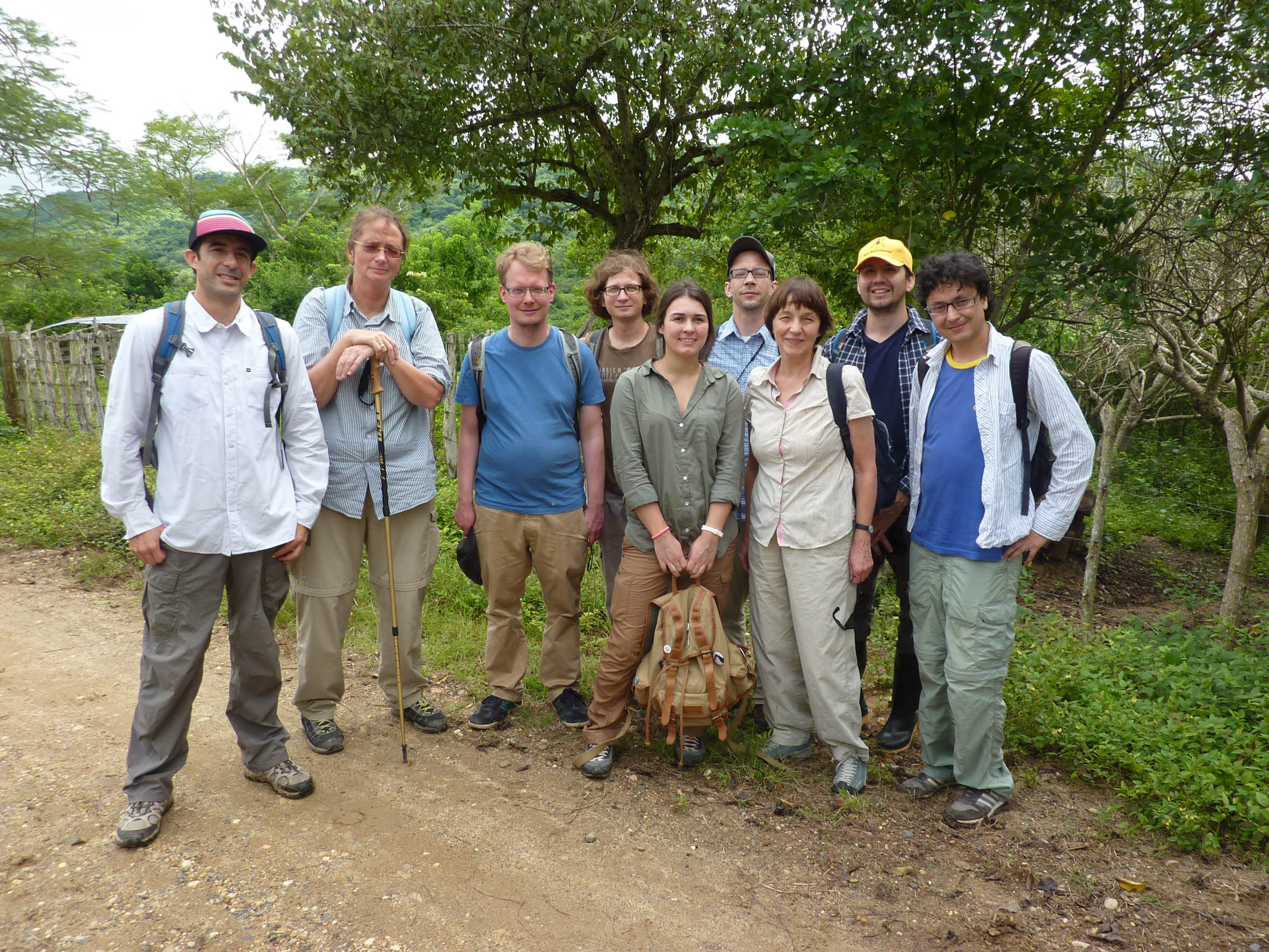 ColBioDiv staff on an excursion in the Colombian Caribbean (LTR: Prof. Andrés Vargas Pérez, Prof. Dr. Brigitta Schütt, Dr. Markus Rauchecker, Henry Schubert, Astrid de Mestier, Dr. Grischa Brokamp, Prof. Dr. Marianne Braig, Prof. Francisco Velásquez Puentes, Oscar Rojas Zamora
ColBioDiv staff on an excursion in the Colombian Caribbean (LTR: Prof. Andrés Vargas Pérez, Prof. Dr. Brigitta Schütt, Dr. Markus Rauchecker, Henry Schubert, Astrid de Mestier, Dr. Grischa Brokamp, Prof. Dr. Marianne Braig, Prof. Francisco Velásquez Puentes, Oscar Rojas ZamoraThe ColBioDiv Project ("Kooperation mit dem Botanischen Garten Bogotá und der Universidad del Norte Barranquilla," reference number 01DN17006, duration 01.01.2017-31.03.2020) is a research project funded by the German Federal Ministry of Education and Research (Bundesministerium für Bildung und Forschung). The project focuses on biodiversity management at a landscape level. Using a transdisciplinary approach, the project includes political and social science issues, as well as environmental. The ColBioDiv project builds on a previous pilot project ("Pilot Project Cooperation with the Bogotá Botanical Garden," funding code 01DN13030, duration 01.09.2013-31.12.2016), during the course of which an integrated research approach was developed. This integrated approach is now being applied in the ColBioDiov project.
Project Aims
The aim of the ColBioDiv project is to generate the knowledge base required for sustainable development through a transdisciplinary research approach (integration of scientific and socio-cultural approaches). The two model regions of the ColBioDiv project in which this approach is being applied are: the Andean region around the capital Bogotá (Bogotá D.C.), and the Carribean region around the business metropolis, Barranquilla in the Department Atlántico in the Colombian Caribbean.
Projekt Structure
The ColBioDiv project is comprised of five work packages: The overarching work package 0 deals with the coordination of the project, as well as network establishment and maintenance. The research activities of work packages I and II deal with vegetation and biodiversity in the model regions and are mainly carried out by biologists. The landscape sensitivity assessment undertaken in work package III, which concentrates on climatic and landscape changes, is carried out by geographers. And the research in work package IV deals with human interaction with the landscape and biodiversity, and is done by political and social scientists. There is however close interaction and cooperation between all five work packages, as well as researchers from the participating disciplines.
Work-package 0: Coordination and Networking
Work package 0 deals with overall project coordination and provides support for communication and cooperation within the project, as well as networking activities with stakeholders outside of the project. Work package 0 also provides logistical support in terms of technical capabilities, including mobility and obtaining necessary permits (e.g. for fieldwork, collection and international exchange of herbarium documents), management of interdisciplinary research tasks (especially in work packages I and II), and the synthesis of the results obtained in all work packages.
Work-package I: Biodiversity Assessment and Analysis
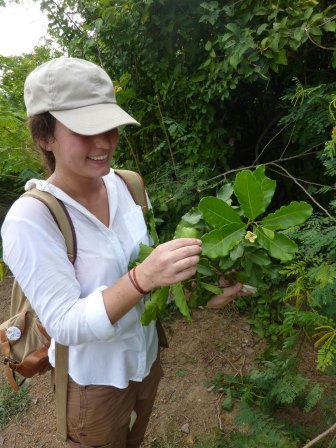 Astrid de Mestier
Astrid de MestierThe objectives of work package I are biodiversity assessment, phylogenetic-taxonomic analysis of relevant plant groups, data management and exchange, and the generation of checklists and identification tools.
Molecular Inventory of Lichens using DNA Barcoding (Robert Lücking, Biology, FUB-BGBM; Bibiana Moncada, Biology, Universidad Distrital Francisco José de Caldas; María Cristina Martínez Habibe, Biology, UniNorte; Pierine España Puccini, PhD Candidate, Biology, UniNorte)
Lichens are highly diverse and play important roles in Andean ecosystems and dry forests, particularly in the water and nutrient cycle and as bioindicators of environmental health. The aim of this project is to undertake an inventory of lichens in the Andean region (páramo, subandine forest, dry valleys) around Bogotá and the dry forests around Barranquilla, supported by DNA barcoding, in collaboration with the Jardín Botánico de Bogotá (JBB), the Universidad Distrital Francisco José de Caldas, and UniNorte. This approach has unveiled an unexpected species diversity, including many species new to science, including among taxa that were presumably well-known. As an example, the basidiolichen Cora, until recently thought to represent a single species, up to now corresponds to at least 32 species in the Cruz Verde/Sumapaz páramo complex in the district of Bogotá alone, almost half of which are exclusive to this complex. This has important implications for conservation management of Colombian páramos. In Colombian dry forests, lichens are systematically inventoried for their diversity of secondary chemical compounds and their potential pharmaceutical applications, in a project by PhD candidate Pierine España Puccini, spearheaded by María Cristína Martínez at UniNorte.
Phylogeny and Biogeography of Selected Plant Groups (Astrid de Mestier, PhD candidate Biology, FUB-BGBM)
The aim of this PhD project is to understand the evolutionary history of selected plant groups that are characteristic components of the Caribbean flora. The focus is on the analysis of molecular biological and morphological data (reconstruction of phylogeny, age estimation, ancestral character states). This, in combination with distribution data, provides insight into historical distribution patterns (ancestral area analysis) which enables the reconstruction of patterns of diversification within the Neotropics. Particularly those evolutionary processes that have taken place between Colombia and the Caribbean Islands.
Work-package II: Land use & Vegetation Cover
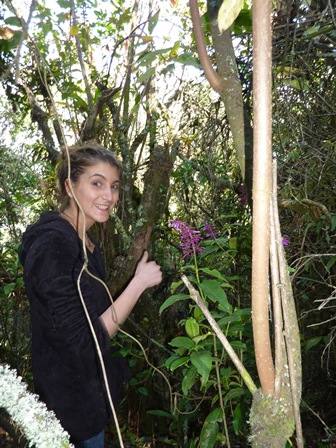 Mariasole Calbi
Mariasole CalbiWork package II focuses on the analysis of vegetation structures and biomass, as well as the identification of indicator species for succession or degradation stadia of ecosystems. The deffinition of entities to be mapped in space, and the documentation and analysis of land use and plot-based land use mapping are alos key research activities.
Analysis of Vegetation Structure and Biomass Production in High Andean Forests (bosques altoandinos) and the Spatial Distribution of the Different Entities (Mariasole Calbi, PhD candidate Biology, FUB-BGBM).
The project aim is to define a categorization of bosque altoandino (high Andean forests) ecosystem condition through vegetation analysis and remote sensing data, which could be up-scaled and applied to the whole Distrito Capital. Plot-based vegetation surveys, remote sensing data, distribution data, and various statistical analyses are the basis for conclusions about past and present ecosystem status. On this basis, sustainable management strategies can be developed (or improved) and appropriate priorities for ecosystem conservation can be set.
Work-package III: Landscape Sensitivity Assessment
Work package III is a landscape sensitivity assessment focusing on climate change and land use change as the main factors influencing the dynamic equilibrium of landscapes. Through this threshold values are estimated, which, if exceeded, lead to an impairment of the resilience of the landscapes and ecosystems, and the corruption of ecosystem services.
Model Region Andes (Norbert Anselm, PhD candidate Physical Geography, FU Berlin)
In the Andean model region (drainage basin of the Rio Bogotá) the focus is on water and water availability for the metropolitan area of Bogotá. Within several working steps I) the trends and causes for land use and land cover change, II) the precipitation distribution, availability, the topographical and ENSO impacts on it and III) runoff characteristics for the Sabana de Bogotá are investigated. These steps are used for a numerical estimation of the drainage basin to draw future development scenarios.
Model Region Caribbean (Henry Schubert, PhD candidate Physical Geography, FU Berlin)
In the Caribbean model region the focus is on analysing the relation between landscape sensitivity, soil erosion risk and land use/land cover changes at various scales. While at the regional scale the trends and causes of land use and land cover changes in the department of Atlántico are investigated, at the local scale the focus is on a comparative analysis of natural resource management and soil erosion risk in the communities of El Morro in the municipality of Tubará and the El Palomar regional protected area in the municipality of Piojó.
Work-package IV: Political Ordering of Biodiversity and Societal Impacts
Work package IV analyses the human dimension (drivers, social and economic actors, political institutions, civil organizations) of integrated biodiversity management and their interactions. The aim is to reconstruct the social and political embeddedness of biodiversity loss and biodiversity management in both model regions. The focus is on social actors, political institutions, and legal norms in regards to the various conflicting uses of biodiversity (e.g. water), and includes an analysis of the production of an order of biodiversity by several state actors in interactions with economic groups and civil society.
Political Ordering Processes of Biodiversity in Colombia - The Cases of Bogotá and Barranquilla (Dr. Markus Rauchecker, Lateinamerika Institut, FU Berlin)
In this sub-project, the socio-political processes that underlie in the transformation and loss of biodiversity in Colombia are analysed. The political handling of the loss of biodiversity is traced by numerous breaking points and conflicts. These are found at the site of the links that bind the biological, social and political realms. These orders are not articulated adequately amongst themselves and are fragmented internally. The project centers on the fragmentations and divisions in the political realm that result of normative conflicts, and the interactions between international, national and regional legal dispositions, in diverse political scenarios.

Model Regions
The study area of the ColBioDiv project focuses on two model regions: the Andean region around the capital Bogotá (Bogotá D.C.) and the hinterland of Barranquilla in the Department Atlántico of the Colombian Caribbean. The unifying element of both study areas is their location in fast-growing regions of Colombia. In both areas water as a resource is crucial for human well-being. Both areas are also of great importance for the conservation of biodiversity. The two systems will be affected differently by global change, and human activities and landscape sensitivity and restoration potential may also differ. Therefore, a comparative analysis of the two study areas provides a representative framework for the development of Integrated biodiversity management in Colombia and allows the identification of factors affecting biodiversity and ecosystem services that operate at different scales within the same country.
Bogotá and the Distrito Capital
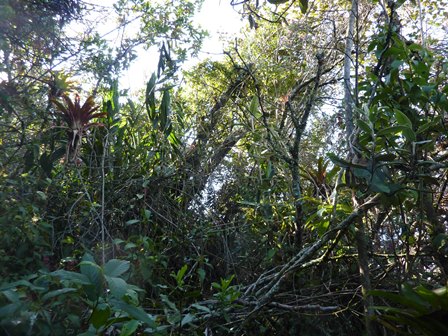 Bosque Alteandino
Bosque Alteandino, Andes
Bogotá is the capital city of Colombia. Although it occupies only about 0.5 % of the country's total area, about 20 % of the population of Colombia lives here and in the surrounding Distrito Capital (the metropolitan area around Bogotá). Strong rural-urban migration, triggered by a steadily growing tertiary economic sector and decades of simmering civil war in the countryside, continues to fuel the growth of agglomerations around Bogotá. This steadily growing urbanisation and shift of agricultural activities to previously semi-natural areas is increasing pressure on the surrounding landscape and ecosystems which contributes to biodiversity loss and impairs the function of ecosystems in the region. The natural vegetation of the Distrito Capital includes the Andean Mountain ecosystems bosque altoandino (high Andean forest) and páramo (high Andean grassland). These ecosystems harbour immense biodiversity, play a significant role in the city's water supply and also act as important carbon sinks.
Barranquilla and surrounding area
Barranquilla and its hinterland are situated in the Department Atlántico of the Colombian Caribbean in the north of the country. Barranquilla is the largest city in the northern coastal region of Colombia and contains the country's largest, most important port for river and sea traffic. The rapid growth of the city of has had significant negative impacts on the surrounding ecosystems. In this region, the bosque seco tropical (tropical dry forest) and the manglares (mangrove forests) are the characteristic vegetation types. bosque seco tropical is the most endangered ecosystem in Colombia, as well as in many other countries of the American tropics. Due to deforestation, less than 8% of original bosque seco tropical areas remain today. The main causes of deforestation are agriculture, livestock, strip mining and coal production. Natural regeneration of bosque seco tropical is often difficult or impossible, meaning that at least half of the Colombian Caribbean region faces a medium to very high risk of desertification, according to the USDA desertification map.
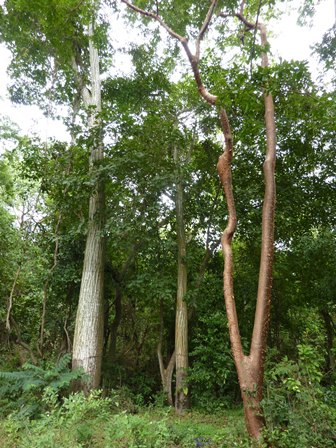 Bosque Seco Tropical
Bosque Seco Tropical, Carribean
Publication List Colombia
Peer-reviewed Journal Articles
Anselm, N., Brokamp, G., & Schütt, B. (2018). Assessment of land cover change in peri-urban High Andean environments south of Bogotá, Colombia. Land, 7(2), 75.
Anselm, N., Rojas, O., Brokamp, G., & Schütt, B. (2020). Spatiotemporal variability of precipitation and its statistical relations to ENSO in the high Andean Rio Bogotá watershed, Colombia. Earth Interactions, 24(3), 1-17.
Borrelli, P., Armenteras, D., Panagos, P., Modugno, S., & Schütt, B. (2015). The implications of fire management in the Andean paramo: a preliminary assessment using satellite remote sensing. Remote Sensing, 7(9), 11061-11082.
Calbi, M., Clerici, N., Borsch, T., & Brokamp, G. (2020). Reconstructing Long Term High Andean Forest Dynamics Using Historical Aerial Imagery: A Case Study in Colombia. Forests, 11(8), 788.
Calbi, M., Fajardo‐Gutiérrez, F., Posada, J. M., Lücking, R., Brokamp, G., & Borsch, T. (2021). Seeing the wood despite the trees: Exploring human disturbance impact on plant diversity, community structure, and standing biomass in fragmented high Andean forests. Ecology and Evolution.
Canal, D., Köster, N., Jones, K. E., Korotkova, N., Croat, T. B., & Borsch, T. (2018). Phylogeny and diversification history of the large neotropical genus Philodendron (Araceae): Accelerated speciation in a lineage dominated by epiphytes. American Journal of Botany, 105(6), 1035-1052.
Canal, D. (2019). Philodendron Schott (Araceae): Systematics and evolution of a mega-diverse genus from the New World (Doctoral dissertation).
Canal, D., Köster, N., Celis, M., Croat, T. B., Borsch, T., & Jones, K. E. (2019). Out of Amazonia and back again: historical biogeography of the species-rich neotropical genus Philodendron (Araceae). Annals of the Missouri Botanical Garden, 104(1), 49-68.
Fajardo-Gutiérrez, F., Moreno, D., Medellín-Zabala, D., Rodríguez-Calderón, Á., Urbano-Apraez, S., Vargas, C. A., ... & Celis, M. (2020). Inventario de la flora vascular de Bogotá DC, Colombia. Pérez-Arbelaezia, 21(1), 25-57.
Lücking, R., Dal Forno, M., Moncada, B., Coca, L. F., Vargas-Mendoza, L. Y., Aptroot, A., ... & Cáceres, M. E. (2017). Turbo-taxonomy to assemble a megadiverse lichen genus: seventy new species of Cora (Basidiomycota: Agaricales: Hygrophoraceae), honouring David Leslie Hawksworth’s seventieth birthday. Fungal Diversity, 84(1), 139-207.
Lücking, R., Moncada, B., Martínez-Habibe, M. C., Salgado-Negret, B. E., Celis, M., Rojas-Zamora, O., ... & Borsch, T. (2019). Lichen diversity in colombian caribbean dry forest remnants. Caldasia, 41(1), 194-214.
Lücking, R., Moncada, B. & Pérez-Ortega, S. (2019). Lawreymyces reloaded - Another attempt at valid description of a ghost fungus. Plant and Fungal Systematics (submitted).
Schubert, H., Caballero Calvo, A., Rauchecker, M., Rojas-Zamora, O., Brokamp, G., & Schütt, B. (2018). Assessment of land cover changes in the Hinterland of Barranquilla (Colombia) using Landsat imagery and logistic regression. Land, 7(4), 152.
Schubert, H., Rauchecker, M., Caballero Calvo, A., Schütt, B. (2019). Land Use Changes and Their Perception in the Hinterland of Barranquilla, Colombian Caribbean. Sustainability, (11), 6729.
Other publications
Calbi, M., Fajardo, F., & Brokamp, G. (2019). Guía de los Árboles y Arbustos Autóctonos de los Bosques Altoandinos de la Vereda Las Vegas de Sumapaz. Plegables del Jardín Botánico Bogotá, Serie Flora de Bogotá No. 7. Jardín Botánico José Celestino Mutis Bogotá & Botanischer Garten Botanisches Museum Berlin.
Calbi, M., Fajardo, F., & Brokamp, G. (2019). Guía de los Árboles y Arbustos Autóctonos de los Bosques Altoandinos de Pasquilla. Plegables del Jardín Botánico Bogotá, Serie Flora de Bogotá No. 6. Jardín Botánico José Celestino Mutis Bogotá & Botanischer Garten Botanisches Museum Berlin.
Calbi, M., Fajardo, F., & Brokamp, G. (2019). Guía de los Árboles y Arbustos Autóctonos de los Bosques Altoandinos de Torca. Plegables del Jardín Botánico Bogotá, Serie Flora de Bogotá No. 5. Jardín Botánico José Celestino Mutis Bogotá & Botanischer Garten Botanisches Museum Berlin.
Moncada, B., Lücking, R., & Sipman, H.J.M. (2015). Líquenes de los Páramos, los Bosques y las Zonas Urbanas del Distrito Capital. Plegables del Jardín Botánico Bogotá, Serie Flora de Bogotá No. 1. Jardín Botánico José Celestino Mutis Bogotá & Botanischer Garten Botanisches Museum Berlin.
Moncada, B., & Lücking, R. (2015). Tropical Lichen Guides. Lichens of the Colombian Páramo. The Field Museum Chicago, Rapid Color Guide #344.
Peñaloza, G.F., Silano Uribe, S., Pérez, A., & Moncada B. (2015). Tropical Lichen Guides. Lichens in the Cemetery of Madrid/Cundinamarca, Colombia. The Field Museum Chicago, Rapid Color Guide #460.
Torres, J.M., Pérez, A., Moncada, B., & Lücking, R. (2015). Líquenes de las Cuencas de los Ríos Fucha y Arzobispo, Bogotá D.C. The Field Museum Chicago, Rapid Color Guide #556.
Vargas, C., Orejuela, & Celis, M. (2017). Guía de la Flora Vascular de la Quebrada La Vieja. Plegables del Jardín Botánico Bogotá, Serie Flora de Bogotá No. 4. Jardín Botánico José Celestino Mutis Bogotá & Botanischer Garten Botanisches Museum Berlin.
Vargas, C., Orejuela, F., Fajardo, F., Cabrera, D., Rojas, O. & Celis, M. (2017). Guía de las Plantas Vasculares de los Matorrales y Bosques del Corregimiento Pasquilla. Plegables del Jardín Botánico Bogotá, Serie Flora de Bogotá No. 3. Jardín Botánico José Celestino Mutis Bogotá & Botanischer Garten Botanisches Museum Berlin.
Vargas, C., Orejuela, F., Fajardo, F., Cabrera, D., Rojas, O. & Celis, M. (2017). Guía de las Plantas Vasculares de los Páramos del Corregimiento Pasquilla. Plegables del Jardín Botánico Bogotá, Serie Flora de Bogotá No. 2. Jardín Botánico José Celestino Mutis Bogotá & Botanischer Garten Botanisches Museum Berlin.
Books and Book chapters
Rauchecker, M., Salcedo Fidalgo, A.(Zur Publikation angenommen). Presencia diferenciada del Estado y gestión de usos del suelo en conflicto en el sur de Bogotá D.C., in: Müller, F., Baquero, J., Rauchecker, M., Segura, R. (Eds.): "Colombia, entre posconflicto y posacuerdo." Territorialidades, temporalidades, materialidades, Bogotá: Editorial Universidad del Rosario.
Conferences & Symposia (Talks & Posters)
Borsch, T. (2019). Talk: Flora y biogeografía del Caribe. Cátedra Europa XXII – Humboldt Kolleg, Universidad del Norte, 18.-23. March 2019, Barranquilla, Colombia.
Brokamp, G. (2019). Talk: Manejo Integrado de la Biodiversidad en el Caribe Colombiano: Avance y Proyección, Cátedra Europa XXII, Universidad del Norte, 2019.03.18, Barranquilla, Colombia.
Calbi, M., Fajardo-Gutiérrez, F., Posada-Hostettler, J., Lücking, R., Brokamp, G. & Borsch, T. (2018). Talk: Estado actual de los bosques altoandinos circundantes de Bogotá: impacto de disturbios sobre la estructura, diversidad vegetal y provisión de servicios ecosistémicos. II Simposio Nacional de Ecología del Paisaje, Universidad Javeriana de Bogotá, 30th November 2018, Bogotá, Colombia.
Calbi, M., Fajardo-Gutiérrez, F., Posada-Hostettler, J., Lücking, R., Brokamp, G. & Borsch, T. (2019). Talk: Assessing impact of human disturbance in shaping forest plant communities structure, productivity and diversity in highly fragmented high-Andean forests. 10th IALE World Congress 2019, International Association for Landscape Ecology. University of Milano-Bicocca, 4 July 2019, Milan, IT.
Celis, M. (2019). Talk: Herbario UNO en línea: información a la mano, Cátedra Europa XXII, Universidad del Norte, 2019.03.18, Barranquilla, Colombia.
De Mestier, A., Gutiérrez Amaro, J., Brokamp, G., Celis, M., & Borsch, T. (2018). Poster: Plants of the Caribbean – Unraveling the phylogeny and systematics of Casearia Jacq., Young Scientist's Forum, Natural History Museum London, 2018.11.23, London, UK.
De Mestier, A., Brokamp, G., Celis, M., & Borsch, T. (2019). Talk: Filogenia y biogeografía de Casearia Jacq., Cátedra Europa XXII, Universidad del Norte, 2019.03.18, Barranquilla, Colombia.
De Mestier, A., Brokamp, G., Celis, M., & Borsch, T. (2019). Talk: Filogenia y biogeografía de Casearia Jacq., Congreso Colombiano de Botánica, Universidad de la Amazonia, 2019.08, Florencia, Colombia.
Lücking, R. (2017). Líquenes del Neotrópico: diversidad, evolutión y aplicaciones. IX Congreso Latinoamericano de Micología, 19-21 August 2017, Universidad Peruana Cayetano Heredia, Lima, Peru.
Lücking, R. (2019). Nuevos acercamientos al concepto de especie en el genero Sticta (Lobariaceae). V Encuentro del Grupo Colombiano de Liquenología (GCOL), 28-31 Januar 2019, Universidad de Antioquia, Medellín, Colombia.
Lücking, R. & Moncada, B. (2017). La complicada naturaleza de la naturaleza: un basidiomicete liquenícola causando una falsa percepción de un ascoliquen. IX Congreso Colombiano de Botánica, "Investigación, Ética y Sociedad: Conservación de la Riqueza Natural", 30. Juli - 3. August 2017, Tunja, Colombia. Revista Ciencia en Desarollo, 8(1), Suppl. Esp.: 52.
Lücking, R. & Moncada, B. (2019). Liquenología en Colombia con Enfoque en el Caribe: Pasado, Presente y Futuro. In: Cátedra Europa, "Homenaje al Natalicio de Alexander von Humboldt 250 Años", Universidad del Norte, 18-22 März 2019, Barranquilla, Colombia.Moncada, B., Dal Forno, M. & Lücking, R. (2018). The genus Cora in Colombia: diversification of a hyperdiverse, basidiolichen-forming clade in the northern Andes. 11th International Mycological Congress (IMC11), "Mycological Discoveries for a Better World", 16-21 Juli 2018, San Juán, Puerto Rico.
Rauchecker, M., Braig, M. (2019): Binational, inter- & transdisciplinary research in the Colombian Caribbean: Political Ordering of Biodiversity in El Morro. International Week 2019, Freie Universität Berlin, Berlin, Germany, 17.- 21. June 2019.
Rauchecker, M. (2019): Presencia fragmentada, volátil y selectiva del Estado: las políticas (in)sostenibles en el sur de Bogotá D.C. XXXVII International Congress of the Latin American Studies Association (LASA2019), Boston, USA, 24.-27. May 2019 (trip funded by DAAD).
Rauchecker, M. (2019): Problemas ambientales y presencia diferenciada del Estado en la zona periurbana del sur de Bogotá D.C. Trandes Workshop “Jornadas de investigación sobre la región andina”, Berlin, Germany, 7. May 2019.
Rauchecker, M., Vargas, A. (2019): El impacto diferencial de las licencias ambientales en Colombia. International Conference Cátedra Europa, Barranquilla, Colombia, 18.-23. March 2019.
Rauchecker, M. (2018): Counter-Mobilization on Different Scales & Levels of Hierarchy – Environmental Conflicts in Argentina & Colombia. Second Biennial Conference of the Political Ecology Network (POLLEN), Oslo, Norway, 19.-22. June 2018
Rauchecker, M. (2018): La (no)regulación política de la interrelación entre zona urbana y rural – Usos del suelo en conflicto en el sur de Bogotá D.C. XXXVI International Congress of the Latin American Studies Association (LASA2018), Barcelona, Spain, 23.-26. May 2018.
Rauchecker, M. (2018): Reconfiguración de cercamientos por la presencia del Estado: Usos de suelo en conflicto en el sur de Bogotá. Workshop “Rethinking Enclosures in Colombia in Regional and Global Context: The Role of Territory, Coloniality, and Temporality”, Bogotá, Colombia, 23.-25. April 2018 (trip funded by Thyssen Stiftung).
Rauchecker, M., Anselm, N. (2018): Environmental Change and Socio-ecological Inequalities in the Sabana de Bogotá – Physical and Socio-political Factors. Trandes Ringvorlesung “Desigualdades sociales y desarrollo sostenible en la región andina”, Berlin, Germany, 11. January 2018
Rauchecker, M. (2017). Talk: Los diferentes objetos del riesgo. IX Congreso de la Asociación Latinoamericana de Ciencia Política (ALACIP), Montevideo, Uruguay 26.-28. July 2017.
Rojas, O. (2019), Talk: Mecanismos de regeneración del Bosque seco tropical: ecología de semillas a través de la sucesión, Cátedra Europa XXII, Universidad del Norte, 2019.03.18, Barranquilla, Colombia.
Schubert, H., Rauchecker, M., Caballero, A. (2019). Talk: Cambios de uso del suelo en un pueblo indígena de la zona periurbana. International Conference Cátedra Europa, Barranquilla, Colombia, 18.-23. March 2019.
Schubert, H. (2019). Poster: Land Use Changes and their Perception in the Hinterland of Barranquilla, Colombian Caribbean, Deutscher Kongress für Geographie (DKG) 2019, Kiel, 25.-30. September 2019.
Schubert, H. (2019). Talk: Analysing the relation between landscape sensitivity and land use/ land cover change in the Colombian Caribbean. UNA EUROPA PhD workshop: "Climate change: from perception to action?", Paris, 18-20 December 2019.
Schütt, B. (2019). Talk: Integrated Biodiversity Management – a conceptual approach. International Conference Cátedra Europa XXII – Humboldt Kolleg, Barranquilla, Colombia, 18.-23. March 2019.
Vargas, A., & Rauchecker, M. (2019). Talk: Las negociaciones del ordenamiento del medio ambiente entre actores estatales, económicos y sociales, Cátedra Europa XXII, Universidad del Norte, 2019.03.18, Barranquilla, Colombia.
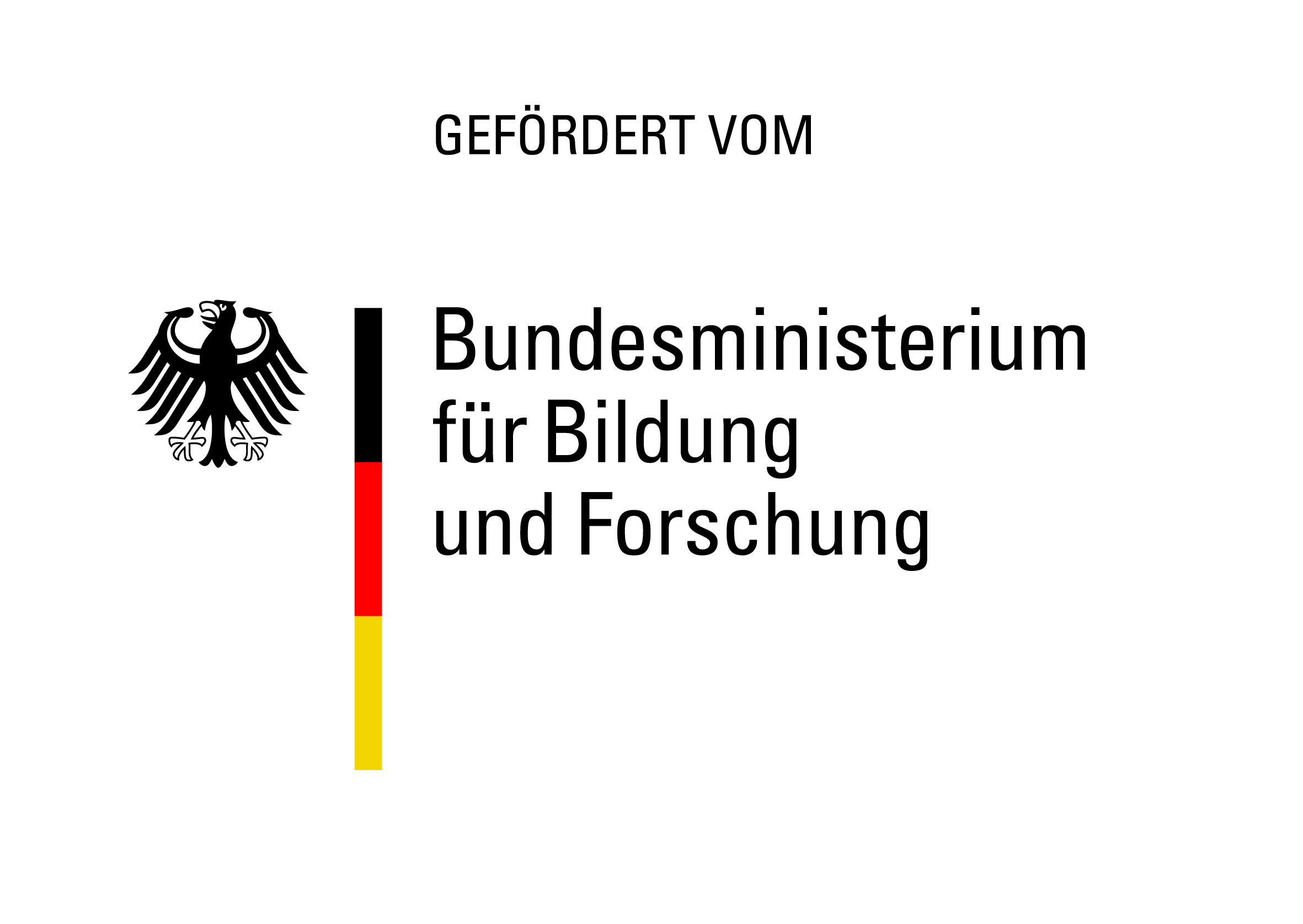
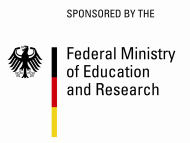

 ColBioDiv staff on an excursion in the Colombian Caribbean (LTR: Prof. Andrés Vargas Pérez, Prof. Dr. Brigitta Schütt, Dr. Markus Rauchecker, Henry Schubert, Astrid de Mestier, Dr. Grischa Brokamp, Prof. Dr. Marianne Braig, Prof. Francisco Velásquez Puentes, Oscar Rojas Zamora
ColBioDiv staff on an excursion in the Colombian Caribbean (LTR: Prof. Andrés Vargas Pérez, Prof. Dr. Brigitta Schütt, Dr. Markus Rauchecker, Henry Schubert, Astrid de Mestier, Dr. Grischa Brokamp, Prof. Dr. Marianne Braig, Prof. Francisco Velásquez Puentes, Oscar Rojas Zamora





